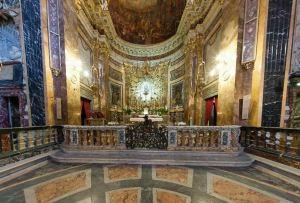Chapter 1
CERN – particle collision detectors.
Chapter 7
Tim Berners-Lee – while working at CERN, he created the basis for the Internet.
Chapter 15
Chapter 19
Georges Lemaître – originator of the concept of the Big Bang.
Edwin Houbble – the famous physicist, who confirmed, providing compelling evidence that the Big Bang theory is plausible from a scientific point of view.
Chapter 31
Vatican Museums. One of the largest world’s collection of art. You can see the works of: Michelangelo, Leonardo da Vinci, Botticelli, Caravaggio, Raphael.
Spiral staircase designed by Michelangelo.
Inside the Vatican Museums.
One of the most famous works in the Vatican Museums – The Laocoon and his sons.
The inner courtyard of Pine
M. C. Escher’s artwork.
Chapter 32
Coat of arms of the Vatican.
The uniform of the Swiss Guard.
Chapter 33
St. Peter’s Basilica in the Vatican.
Chapter 35
Conclave.
Sistine Chapel.
Vatican Radio Building.
Chapter 42
Mayer Amschel Rothschild, one of the key figures allegedly Masonic Rothschild family.
Bilderberg – the place of the first meeting, which is also probably freemasonry – the Bilderberg Group.
The Last Judgement – Sistine Chapel fresco by Michelangelo.
Chapter 49
Vatican Archives.
Diagramma della Verita by Galileo.
Galileo and Milton-image by Annibale Gatti.
Chapter 60
Pantheon
Raphael’s tomb in the Pantheon.
Chapter 62
Mona Lisa by Leonardo da Vinci.
Water Lilies – Claude Monet.
David – Michelangelo.
Chapter 64
Piazza del Popolo, visible obelisk.
Basilica of Santa Maria del Popolo-Basilica of Our Lady of All the People.
Chapter 65
Pinturicchio’s fresco in the church of Santa Maria del Popolo.
Chigi Chanel.
Demon hole in the floor – visible symbols of the Illuminati, pyramids and stars. Source >>
Chapter 67
Ambigram Earth.
Chapter 69
“Habakkuk and the Angel” – sculpture artist whose art can surpass Michelangelo’s only talent – Gian Lorenzo Bernini.
Chapter 72
Caligula Obelisk in front of the Basilica of St. Peter. Along with the base and the cross obelisk measures 39.81 m in height. Dates from the thirteenth century BC, between 37-41 brought him to Rome, the emperor Caligula. In 1586, Pope Sixtus V ordered to move it to its current location architect Domenico Fontana. Obelisk then bears inscriptions in Latin.
West Ponente at Saint Peter’s Square.
Chapter 75
Ambigram Air
Chapter 83
The interior of St. Peter’s Basilica.
Bernini’s canopy design is 29 meters and weighs 90 tons. It was carved out of gilded bronze in the years 1624-1635.
The descent to the tomb of St. Peter.
Grotto of the Vatican – the resting place of the popes.
Chapter 88
Piazza Barberini and the Triton Fountain sculpted by Bernini. In the background, Hotel Bernini.
Chapter 91
Church of Santa Maria della Vittoria.
Virtual panorama of the interior of the church.
Ambigram Fire
Chapter 93
Ecstasy of Saint Teresa-Bernini.
Chapter 102
Piazza Navona. Fountain of Neptune with a group of sea nymphs – was designed by Giacomo della Porta in the sixteenth century. Neptune statue was added in 1878. In the deep the Church of Agnes – Design Francesco Borromini.
Piazza Navona. The second fountain in the square – del Moro Fountain with central figure Maur designed by Bernini.
Piazza Navona. Centrally placed third fountain – Fountain of the Four Rivers. The sculpture was composed around the Egyptian obelisk. Four characters, along with elements of the landscape in the form of palm trees and animals symbolize the four rivers of the four continents. Rio de la Plata in America represents the character with raised hand.The Danube in Europe, imagine character on the horse, the Nile in Africa has sheathed head beckause was not known then still its sources. Asia embodies the Ganges - the form with an anchor. The Fountain of the Four Rivers is linked to a certain legend that tells of a great rivalry between Bernini and Borromini. As Bernini considered him inferior artist, sculptures turn away, hide the eyes, or even appear to be frightened nearby facade church. Agnes, which was designed by Borromini.
Ambigram Water
Chapter 105
Castel Sant’Angelo on the Tiber stormy. Built around 139, as the Emperor Hadrian mausoleum.
Sant’Angelo Bridge to the castle.
Chapter 110
Il Passetto – the secret passage connecting the Vatican to Castel Sant’Angelo.
Chapter 111
Clementine Hall at the Vatican – a place for meetings and ceremonies. Here is exposed the body to the Pope after his death.
Chapter 116
Illuminati Diamond.




























































Brak komentarzy :
Prześlij komentarz